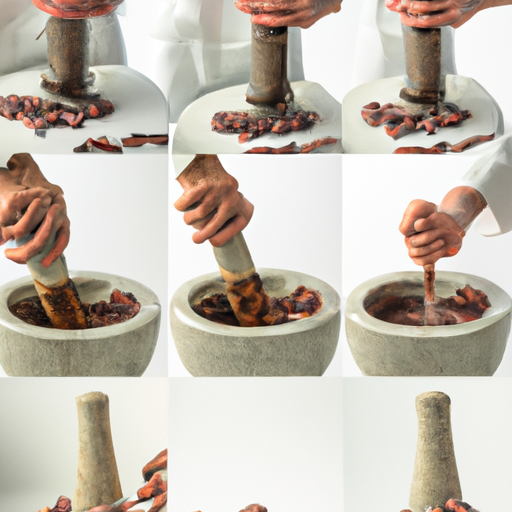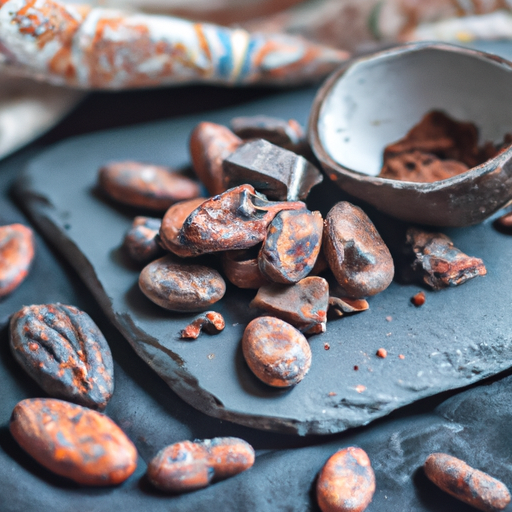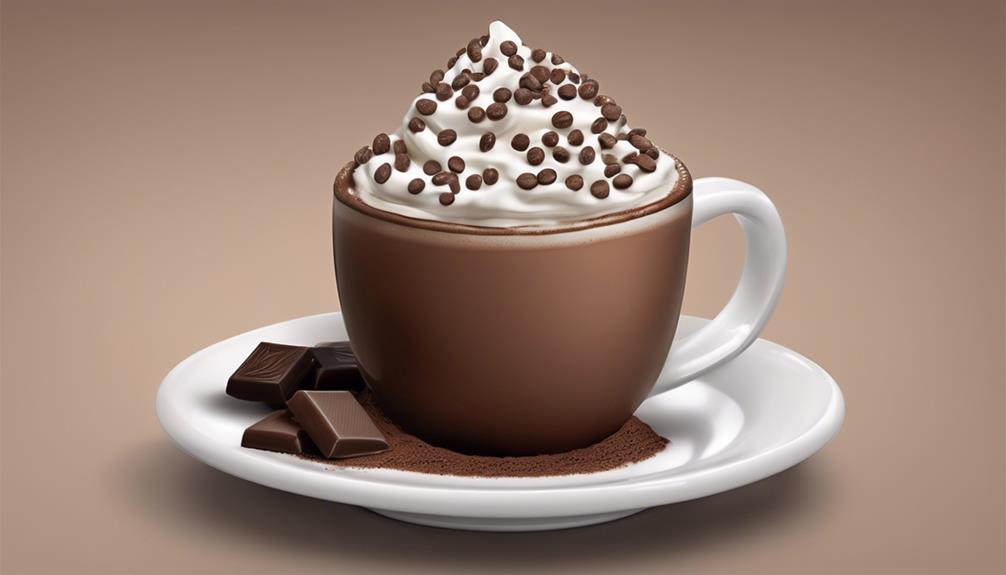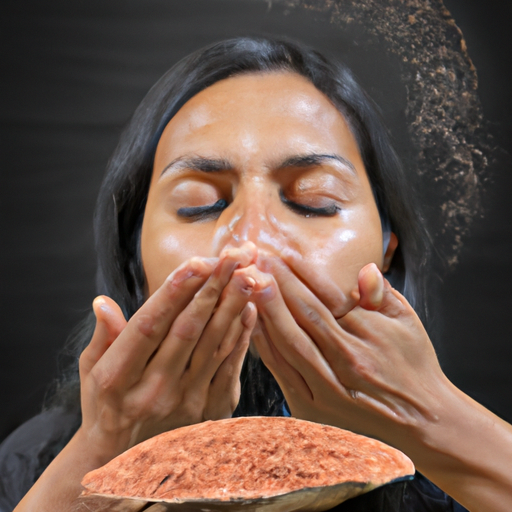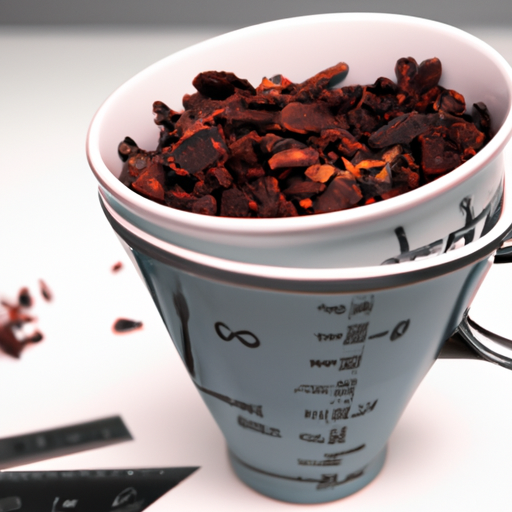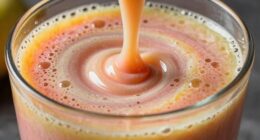Have you ever heard of cold-pressed juices? Well, get ready to be amazed by cold-pressed cacao! Join us in exploring the world of cold-pressed cacao beans and uncovering the secrets of this intriguing process in this article.
But first, let’s talk about cacao beans. These little powerhouses of flavor and nutrition have been captivating humanity for centuries. From their origins in the lush rainforests of Central and South America to their journey into our kitchens, cacao beans have a rich history that’s worth exploring.
Now, when it comes to cold pressing cacao beans, it’s all about preserving the natural goodness locked inside. By using a gentle, low-temperature process, we can extract the purest form of cacao, packed with antioxidants and essential nutrients. Trust me, once you taste the velvety smoothness of cold-pressed cacao, you’ll never go back.
So, grab your apron and join me on this cacao-filled adventure. Together, we’ll uncover the secrets of cold-pressed cacao and discover how to create delicious treats right in the comfort of your own home.
Let’s get started!
Key Takeaways
- Cold-pressing cacao separates cacao solids from cacao butter while retaining higher concentrations of nutrients and antioxidants compared to traditional methods.
- The cold-pressing process enhances the flavor and aroma of raw cacao beans through low temperature, slow pressing, and minimal processing.
- Cold-pressed cacao can be used in various culinary creations such as smoothies, desserts, and savory dishes, adding rich flavor and natural sweetness without excessive sugar.
- In addition to culinary uses, cold-pressed cacao can also be used in skincare for its antioxidants and anti-inflammatory properties.
The Origins of Cacao Beans
The origin stories of cacao beans are rooted in the ancient civilizations of the Mayans and Aztecs. These cultures held cacao in high regard, attributing great historical significance to its consumption. Cacao beans were often used as currency, and the Mayans even believed that cacao trees were a gift from the gods. The beans were so highly prized that they were reserved for the elite and used in religious ceremonies.
The journey of cacao beans begins with their harvesting and fermenting. But before we delve into that process, let’s explore how these beans became such a coveted commodity.
Now, let’s move on to the next section on harvesting and fermenting cacao beans.
Harvesting and Fermenting Cacao Beans
When picking ripe cacao pods, it’s essential to carefully select those that have reached their optimal stage of maturity.
The fermentation process that follows is a critical step in the production of high-quality cacao beans. Proper fermentation is of utmost importance as it allows for the development of complex flavors and aromas that are characteristic of fine chocolate.
Picking ripe cacao pods
To successfully pick ripe cacao pods, you’ll need to carefully evaluate their vibrant color and plumpness, ensuring you select only the most luscious fruits for the finest cold-pressed cacao experience. Picking techniques play a crucial role in determining the quality of the beans and subsequently the flavor profile of the final product. Assessing the ripeness of cacao pods involves examining their external appearance and gently squeezing them to feel their firmness. A ripe pod should have a deep, rich color and feel slightly soft to the touch. Avoid pods that are too green or have any signs of mold or damage. By employing these quality assessment techniques, you can ensure that only the best pods are chosen for the next step in the process: the fermentation process, which is pivotal in developing the complex flavors of the cacao beans.
Fermentation process
The fermentation process is crucial in transforming the flavors and aromas of cacao pods. It is a key step in producing high-quality cacao beans, as it develops desired flavors and removes unwanted bitterness. Various fermentation techniques can be used, such as wooden boxes or banana leaves. The duration of fermentation varies depending on climate and desired flavor profile, typically lasting 2 to 7 days. During this time, chemical changes occur, including protein breakdown and the development of fruity and floral notes. Proper fermentation is essential for flavor development and sets the foundation for subsequent steps in the cold pressing process, enhancing the overall taste and quality of the final cacao product.
Importance of proper fermentation for flavor development
Proper fermentation is crucial in creating the enchanting and complex flavors that make high-quality chocolate so irresistible. The fermentation process of cacao beans is a delicate and intricate art, requiring specific techniques to achieve the desired flavor profile.
Different fermentation methods, such as heap, tray, or box fermentations, can have a significant impact on the final taste of the chocolate. During fermentation, yeasts and bacteria break down the pulp surrounding the cacao beans, converting sugars into alcohol and acids. This microbial activity not only generates heat but also produces various aromatic compounds that contribute to the unique flavor notes of the chocolate.
The duration and temperature of fermentation play a pivotal role in shaping the flavor intensity, acidity, and bitterness of the cacao. Therefore, mastering the art of proper fermentation is essential for chocolate makers to unlock the full potential of raw cacao beans.
Transitioning into the subsequent section about drying and roasting cacao beans, it is important to carefully control these steps to preserve the flavor developed during fermentation.
Drying and Roasting Cacao Beans
First, you’ll need to dry the cacao beans until they reach a moisture level of around 7%. This is a crucial step in the process of preparing cacao beans for cold pressing.
There are several drying techniques available, including sun drying, mechanical drying, and using specialized drying machines. Sun drying is the traditional method, where the beans are spread out in the sun and turned regularly to ensure even drying. Mechanical drying involves using hot air or low-temperature ovens to remove moisture from the beans.
Once dried, the beans are ready for roasting. Roasting is essential for developing the desired flavor and aroma in the cacao beans. Different roasting methods, such as hot air roasting or drum roasting, can be employed to achieve the desired results.
The next step, after drying and roasting the cacao beans, is grinding and pressing to extract the rich cacao butter and create the final product.
Grinding and Pressing Cacao Beans
When grinding cacao nibs into a paste, it is important to achieve a smooth consistency to ensure a high-quality end product. The role of heat and pressure in cold-pressing is crucial in extracting the natural oils and flavors from the cacao beans while still preserving their nutritional benefits.
Once the cacao paste is formed, the next step involves separating the cacao solids from the cacao butter, which can be achieved through a process called pressing. This process results in a rich and velvety chocolate product.
Grinding cacao nibs into a paste
To start grinding cacao nibs into a paste, simply place them in a grinder and let the machine work its magic. When it comes to grinding techniques, it is essential to find the right balance between time and speed.
Over-grinding can result in a paste that is too smooth, while under-grinding can leave behind gritty particles. The goal is to achieve a paste consistency that is smooth and velvety, with a slightly gritty texture.
This can be achieved by grinding the nibs for about 15-20 minutes at a medium speed, periodically scraping down the sides of the grinder to ensure even grinding.
Once the cacao nibs have been transformed into a paste, it is important to understand the role of heat and pressure in the cold-pressing process, which will be discussed in the subsequent section.
The role of heat and pressure in cold-pressing
After grinding cacao nibs into a paste, the next step in cold pressing raw cacao beans involves the crucial role of heat and pressure.
Heat is used during the fermentation process to develop the unique flavors of the cacao beans. This fermentation process helps break down the complex compounds in the beans, resulting in a smoother and more complex flavor profile.
Once fermented, the beans are subjected to pressure to extract the cacao butter, which is the fat component of the beans. This pressure is applied without the use of additional heat, which is why the process is called cold pressing.
The combination of heat and pressure in cold pressing is essential for extracting the rich flavors and aromas from the cacao beans, creating a truly exquisite final product.
Now, let’s delve into the next step of separating the cacao solids from the cacao butter.
Separating cacao solids from cacao butter
During this step, the rich and velvety cacao butter is carefully separated from the smooth and decadent cacao solids. This process requires precision and expertise to ensure a high-quality extraction.
The separation begins by subjecting the crushed cacao beans to a controlled pressure and temperature environment. As the pressure is applied, the cacao solids, which contain the majority of the bean’s flavor and aroma, start to separate from the cacao butter. This separation is facilitated by the difference in melting points between the two components.
The cacao solids, with their intense chocolatey taste, are retained for further processing, while the cacao butter, known for its creamy texture, is carefully collected. The result is a pure and unadulterated cacao butter, ready to be incorporated into various culinary creations.
Moving forward, let’s explore the benefits of cold-pressed cacao.
The Benefits of Cold-Pressed Cacao
When it comes to cold-pressed cacao, there are several key benefits to consider.
First and foremost, this method of processing retains a higher concentration of nutrients and antioxidants compared to traditional methods.
Additionally, the cold-pressing process enhances the flavor and aroma of the cacao, resulting in a more rich and complex taste.
Lastly, consuming raw cacao is known to provide a range of health benefits, including improved cardiovascular health, enhanced mood, and increased energy levels.
Retaining nutrients and antioxidants
To maximize the nutrient content and preserve the antioxidants, it’s essential to handle the raw cacao beans with utmost care during the cold pressing process.
Cold pressing is a method that involves grinding the beans into a paste and then applying pressure to extract the oil. This process helps retain the texture of the beans while also preserving their flavor.
The low temperature used in cold pressing ensures that the nutrients and antioxidants present in the cacao beans are not destroyed or degraded. By avoiding heat exposure, cold pressing helps maintain the integrity of the beneficial compounds in the beans.
The subsequent section will explore how this careful handling of cacao beans during cold pressing contributes to their enhanced flavor and aroma.
Enhanced flavor and aroma
The careful handling of cacao beans through cold pressing brings out their enhanced flavor and aroma. This flavor extraction process involves specific processing techniques that maximize the taste and scent profile of the raw cacao beans. Here are three key elements that contribute to the enhanced flavor and aroma of cold-pressed cacao:
-
Low temperature: Cold pressing uses low temperatures throughout the extraction process, which helps to preserve the delicate flavor compounds present in the cacao beans.
-
Slow pressing: The slow pressing method allows for a gradual release of flavors, ensuring the extraction of a wide range of aromatic compounds from the beans.
-
Minimal processing: Cold pressing involves minimal processing, avoiding excessive heat or chemical treatments that can alter the natural flavor and aroma of the cacao beans.
By employing these precise techniques, cold pressing enhances the flavor and aroma of raw cacao beans, resulting in a rich and complex taste profile.
Transitioning to the subsequent section about the health benefits of raw cacao, it is important to note that these processing techniques also help to retain the beneficial nutrients and antioxidants found in the beans.
Health benefits of raw cacao
Indulging in the velvety richness of cold-pressed cacao unlocks a treasure trove of health benefits that nourish both body and soul. Unlike traditional cocoa powder, raw cacao is minimally processed, retaining its high levels of antioxidants, minerals, and nutrients. These powerful compounds have been linked to a range of health benefits, including improved heart health, reduced inflammation, and enhanced cognitive function. Additionally, raw cacao is known to boost mood and increase serotonin levels, promoting a sense of well-being.
To further emphasize the nutritional superiority of cold-pressed cacao, consider the following table:
| Nutrient | Raw Cacao |
|---|---|
| Magnesium | High |
| Iron | Abundant |
| Fiber | Rich |
| Flavonoids | Abundant |
With its remarkable nutrient profile, raw cacao can be incorporated into various culinary uses, such as smoothies, desserts, and even savory dishes.
Transitioning into the subsequent section about making cold-pressed cacao at home, let’s explore the process of extracting the rich flavors and health benefits from raw cacao beans.
Making Cold-Pressed Cacao at Home
Making cold-pressed cacao at home is a simple and rewarding process. It starts with selecting high-quality raw cacao beans that are free from contaminants. After cleaning the beans and removing any unwanted debris, they are ground into a fine powder using a cold-press juicer or a specialized cacao grinder. This method ensures that the temperature remains low, preserving the delicate flavors and nutritional properties of the cacao. The resulting rich and smooth paste can be used in a variety of recipes, adding a decadent and intense chocolate flavor. Incorporating cold-pressed cacao into your favorite dishes will take your culinary creations to new heights.
Using Cold-Pressed Cacao in Recipes
Get ready to elevate your culinary creations with the intense and decadent chocolate flavor of cold-pressed cacao in these mouthwatering recipes. Using cold-pressed cacao in skincare can provide numerous benefits, as it is rich in antioxidants and has anti-inflammatory properties that can help nourish and rejuvenate the skin.
Incorporating cacao in desserts not only adds a rich and indulgent flavor, but it also provides a natural sweetness without the need for excessive sugar. Some delicious recipes to try include:
-
Cacao avocado mousse: Blend ripe avocados, cold-pressed cacao powder, and a touch of sweetener for a creamy and healthy dessert option.
-
Cacao energy balls: Combine dates, nuts, cold-pressed cacao powder, and a pinch of salt for a nutrient-packed snack.
-
Cacao smoothie bowl: Blend frozen bananas, almond milk, cold-pressed cacao powder, and your favorite toppings for a delicious and energizing breakfast treat.
Now, let’s transition into exploring the world of cold-pressed cacao products and how they can enhance your culinary adventures even further.
Exploring the World of Cold-Pressed Cacao Products
Now, let’s embark on a delightful journey through the extraordinary realm of cold-pressed cacao products and witness how they can effortlessly elevate your culinary escapades to new heights.
Cold-pressed cacao is not only a delicious ingredient but also offers numerous health benefits. By incorporating cold-pressed cacao into your recipes, you can create delectable treats that are both indulgent and nourishing.
From decadent chocolate cakes to creamy truffles, the possibilities are endless. The unique process of cold pressing retains the natural goodness of cacao beans, preserving their rich flavor and nutritional value.
Packed with antioxidants, minerals, and mood-boosting compounds, cold-pressed cacao is a true superfood. So, as we delve into the world of cold-pressed cacao recipes, get ready to savor the fruits of your labor and experience the true bliss of chocolatey delights.
Enjoying the Fruits of Your Labor
Indulge in the exquisite rewards of your efforts as you savor the delightful treats crafted with the goodness of cold-pressed cacao. When you cold press raw cacao beans, you retain the maximum amount of nutrients, resulting in products that offer exceptional health benefits.
The cold-pressing process involves crushing the beans at low temperatures, ensuring that the natural enzymes and antioxidants are preserved. This method also prevents the loss of essential fatty acids, vitamins, and minerals that are often destroyed during traditional heat processing.
By choosing cold-pressed cacao products, you can enjoy the full spectrum of nutrients that cacao has to offer. From improved heart health to enhanced mood and cognitive function, the health benefits of cold-pressed cacao are truly remarkable.
So go ahead, treat yourself to these indulgent creations and reap the rewards of their nutrient-rich goodness.
Frequently Asked Questions
What is the best type of cacao bean to use for cold pressing?
The best cacao bean varieties for cold pressing are the ones that make your taste buds sing and your body feel like a superhero. Cold pressed cacao retains more nutrients, antioxidants, and flavors, elevating your chocolate experience to a whole new level.
Can I cold press cacao beans without a specific cold press machine?
I can cold press cacao beans without a specific cold press machine by using alternative methods. Some cold pressing alternatives include using a manual press or a hydraulic press. Additionally, cacao beans have alternative uses such as making chocolate or cocoa powder.
How long does it take to cold press cacao beans?
Cold pressing cacao beans takes time, like brewing a perfect cup of tea. The process can range from 12 to 48 hours, depending on desired flavors. Cold pressing enhances the rich, natural taste and preserves the beneficial antioxidants present in cacao beans.
Are there any health risks associated with consuming cold-pressed cacao?
Consuming cold-pressed cacao may have potential health risks. Research suggests that it could impact cardiovascular health, possibly due to its high fat content. It may also lead to gastrointestinal issues, such as diarrhea or bloating.
Can I use cold-pressed cacao in baking recipes?
In baking, cold-pressed cacao offers an alternative to regular cocoa powder. With its intense flavor and rich nutrients, it elevates the taste and health benefits of your creations. It contains antioxidants, minerals, and fiber, making it a valuable addition to any recipe.
Can Cold Pressing Raw Cacao Beans Enhance Their Psychoactive Effects?
Cold pressing raw cacao beans is believed to preserve their natural psychoactive compounds. To maximize the effects, learn how to use cacao raw: Crush the beans into a powder and mix with warm liquids or sprinkle it on smoothies, desserts, or oatmeal. Experiment with recipes to enjoy the potential mind-enhancing benefits.
Conclusion
In conclusion, I am astounded by the intricate journey these humble beans undertake to become the delectable treat we know and love. From their origins in tropical regions to the careful harvesting, fermenting, drying, roasting, grinding, and pressing processes, every step contributes to the rich flavor and numerous health benefits of cold-pressed cacao.
As I sip on a warm cup of homemade cold-pressed cacao, I can’t help but appreciate the labor and artistry behind this indulgence. It truly is a testament to the wonders of nature and human ingenuity.

